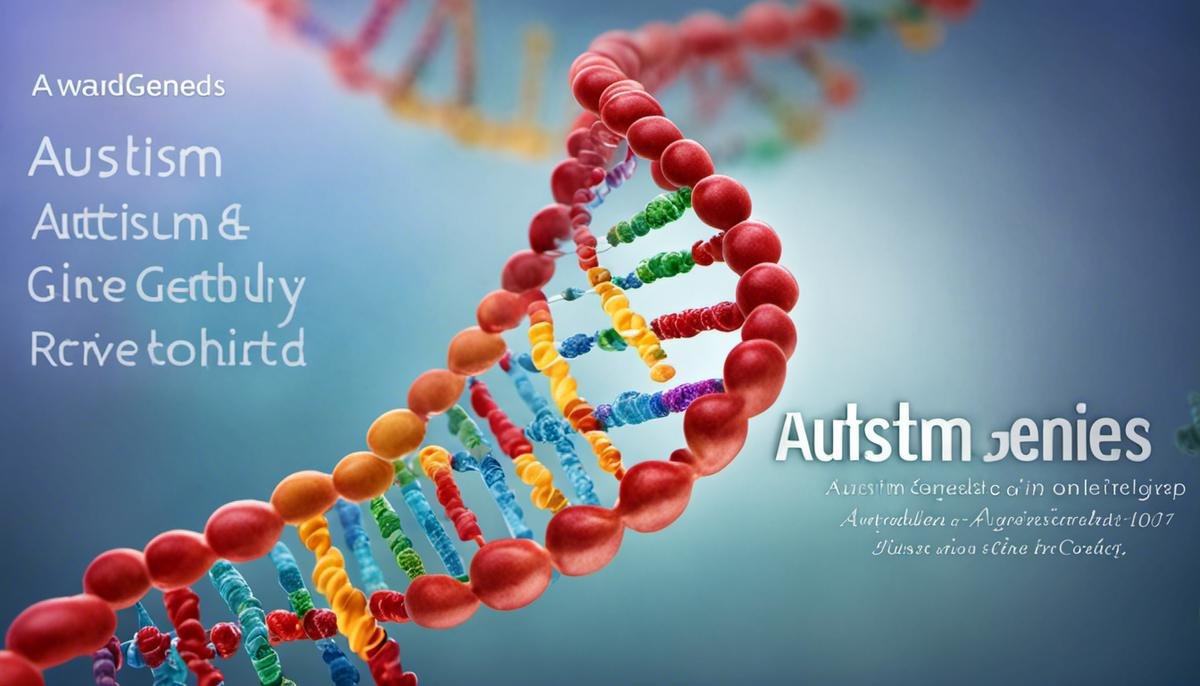
In the vast domain of human health and genetics, a great spectrum of conditions impacts the lives of individuals and their families. Autism Spectrum Disorder (ASD) stands as a complex, intricate subject that has increasingly come to the forefront of public and scientific interest. Given its prevalence, understanding autism is an essential step towards a more compassionate, inclusive society. This exploration delves into the heart of what autism is – its characteristics, its diversity, and why it deeply matters. We’ll also unfold the curtains on the intriguing role of genetics in autism development, a puzzle that continues to expand as research progresses. This discourse will illuminate the mother’s and father’s genetic influence on autism, bringing to light the scientific perspective on this fascinating subject. Equally significant, we will be shedding light on how to create an enriching life for those who have autism, celebrating their unique attributes while offering useful, concrete advice for families.
Autism Basics
Understanding Autism: A Significant Chapter in Our Parenting Journey
Autism: a word that many of us have heard, but may not fully understand. It’s a term that has been thrown around on the news, on social media, and possibly even in the midst of parenting discussions. But what exactly is autism and why is it such an important topic in our parenting journey?
Autism, or autism spectrum disorder (ASD), refers to a broad range of conditions characterized by challenges with social skills, repetitive behaviors, speech, and nonverbal communication. The term “spectrum” highlights the wide variety of issues individuals with autism might face and the extent to which they affect a person’s life. Some people may stay largely independent, while some may need more substantial, lifelong support. There isn’t a “one-size-fits-all” description of a person with autism because each individual’s situation is unique.
But why is understanding autism relevant in our parenting journey? Well, autism is growing increasingly prevalent. According to the Centers for Disease Control and Prevention (CDC), 1 in 54 children in the United States is diagnosed with an autism spectrum disorder. Chances are that a child on the autism spectrum may be in the same neighborhood, school class, or sports team as our children – if not within our own family.
As parents, it’s important to understand and accept autism not just to provide unconditional love and support if our children are diagnosed but also to raise them as empathetic individuals. Teaching children about autism fosters understanding and acceptance, cultivating a more inclusive society.
Moreover, the early signs of autism often appear before a child turns 3. Being aware of these signs—such as delayed speech, minimal eye contact, or repeated behaviours—allows early intervention. And this early intervention is key; it can significantly support development and improve the quality of life for those with autism.
Besides, parenting a child with autism brings its own set of unique and beautiful joys. Sure, it comes with challenges, but what parenting journey doesn’t? Children diagnosed with autism may see the world differently—bringing a fresh perspective and a unique vibrancy to life. They can teach us incredible lessons about patience, kindness, and viewing life through a different lens.
Understanding autism allows us to become well-informed advocates, whether it’s for our own children diagnosed with autism or simply advocating for a more inclusive and understanding society. It teaches us to celebrate diversity and aids in redefining our perception of ‘normal.’
Remember, being different is not lesser—it’s just different! By embracing autism, we create a world that’s accepting and open-hearted, and that’ll reflect in the way we shape the lives of our little ones. Understanding Autism in this light truly makes it a significant chapter in our parenting journey.

Genes and Hereditary Aspects of Autism
When we begin to delve into the causes of autism, it’s natural to wonder about the role of genetics. A major question being asked by parents, doctors, and researchers alike is: How significant is the contribution of genetics in the development of autism? Well, let’s unpack that together.
Research tells us that autism isn’t caused by one single factor but by a combination of genetic, biological, and environmental influences. Genetic factors are considered to be the most significant contributors, accounting for 56% to 95% of autism risk, according to a study published in JAMA Psychiatry.
What does this mean exactly? Essentially, it suggests that certain genetic conditions make an individual more likely to develop autism. But remember, it’s not a one-size-fits-all concept. Even identical twins, who share the same genetic makeup, can have different experiences with autism: one might be diagnosed with autism while the other is not. Proving, indeed, that other factors, including environmental influences, come into play.
That said, understanding that genetics has a hand in the occurrence of autism can provide some peace of mind. It helps put to rest any misplaced guilt parents might feel about somehow “causing” their child’s autism, which is simply untrue. The knowledge that genetic predisposition can lead to autism asserts the fact that parents should never shoulder blame for their child’s diagnosis.
This understanding also opens doors to further scientific research. Recognizing the genetic aspect of autism helps scientists investigate how exactly genes may predispose individuals to autism, and assists in exploring potential interventions.
One fascinating field of research is genetic sequencing, where scientists analyze the DNA of individuals with autism and their families to find common genetic markers. This valuable information can enable early detection, paving the way for early intervention which, as we already know, can significantly enhance a child’s life.
What should parents make of all this genetic talk around autism? It doesn’t mean that the destiny of a child is written solely in their DNA. It simply means that it’s one of the many factors that could influence the development of autism. Most importantly, understanding the genetic links to autism shifts the prevailing narrative around autism, reflecting it as a natural human variance rather than an anomaly.
Genetics or no genetics, every child is unique, and a diagnosis of autism doesn’t diminish their potential. It simply paves the way for parents to better understand their child’s needs, guiding them in the journey of embracing the beautiful diversity that comes with raising a authentically different child. Pursue patience, embrace understanding, and above all, constantly shower your children with unconditional love – these remain the golden rules in the playbook of parenting. So, parents, don your superhero capes, because you’re doing an amazing job! And always remember, in the world of parenting, love trumps genetics every time.
In conclusion, while the role of genetics in autism can be quite significant, it doesn’t define the totality of a person’s life. It’s not a determinant of a child’s worth or ability to lead a fulfilling life. It’s merely another piece of the puzzle in understanding the diverse spectrum that is human existence. Together, armed with love, understanding, and science, we can continue to build more inclusive communities, celebrating the uniqueness of each and every child.

Autism and the Mother’s Genetics
The Landscape of Genetic Influence in Autism
When walking the intricate path of the parenting journey, one often wonders why things are the way they are. This is particularly true for parents of children with autism. While appreciating the beauty of neurodiversity in our children, it’s also important to comprehend the intricacies it involves. This brings us to an essential query often asked – does a mother’s genetics play a key role in a child developing autism?
Coming across various scientific studies and research papers, one would notice the consensus among professionals that there’s a substantial genetic component related to the risk of developing autism. It is believed that up to 90% of the risk is attributed to genes; however, it would be an oversimplification to solely link mother’s genes to the autism spectrum disorder (ASD).
It’s a semblance of a jigsaw puzzle, where the pieces are genes inherited from both parents, each contributing to autism risks in ways that are still not fully understood. While some mutations may increase the chance of autism, they don’t guarantee that a child will have the disorder. It’s a complex interaction of many genes coupled with environmental factors that come into play.
As we delve into this topic, it becomes evident that there are countless genetic conditions, such as Fragile X Syndrome and Tuberous Sclerosis, that could escalate the likelihood of developing autism. This interconnectedness in genetics illuminates the complexity of autism, thereby redefining our comprehension around it.
A blending of environmental elements with genetic makeup can also influence autism. Elements such as exposure to pollutants, parental age at conception, and complications during birth are being examined for their roles in the autism occurrence. This unique dance between genes and the environment elucidates the multifaceted nature of autism.
Yet, it’s crucial to dismiss misplaced guilt concerning autism. As parents, we didn’t cause our child’s autism. Understanding the genetic component reinforces this fact and helps negate any sense of blame. It also encourages us as parents and a society to build inclusive communities, endorsing compassion and acceptance for children on the autism spectrum.
The significance of comprehending genetics transcends just knowing the cause; it propels scientific research and future interventions. With advances in genetic sequencing, there’s promise for the early detection and possibly intervention for ASD, providing a clearer roadmap for future generations.
Autism, though influenced by genes, doesn’t define the capability or worth of a person. Nor does it limit their potential for happiness and success. Each individual with autism is a beautiful piece of the human mosaic. Our job as parents and as part of a community is to shower them with patience, understanding, and unconditional love.
As great advocates of neurodiversity, we celebrate our unique children and stress the importance of understanding that genes do not determine an individual’s potential to live a thriving life. It’s in this collective understanding that we shape an inclusive, loving society that values each person, viewing autism not as a flaw, but as a different way of experiencing the grand tapestry of life.

Autism and the Father’s Genetics
Continuing the discussion on Autism, it’s time to delve deeper into the role of the father’s genes in autism development. With the understanding that autism is a complex condition with a diverse range of symptoms and characteristics, one area of growing interest among scientists and researchers is the potential contribution of paternal genetics to autism.
In scientific research over the years, it has been increasingly recognized that a father’s genes play a significant role in the genetics of autism. Research suggests that mutations in the sperm’s DNA could potentially contribute to the development of autism in a child, particularly as a father ages. The more a person’s DNA replicates – which happens each time sperm are produced – the higher the chance of a replication error, which is a sort of genetic typo that can lead to potential changes in a child’s development. Thus, the connection between a father’s age at child conception and an increased risk of autism has been an area of focused study.
However, it’s essential to understand that while older fathers’ age is indeed associated with an increased risk of autism, it is still just one piece of the jigsaw puzzle. Autism is not solely a question of genetics but rather a complex interplay of both genetic and environmental factors. Stressors during pregnancy, dietary factors, geographical location, and more can interact with genetic predisposition to influence autism’s presentation.
Sometimes, there’s a tendency for parents, more often fathers in this context, to bear the burden of misplaced guilt or blame. Navigating through misconceptions around autism can be challenging. It’s vital to understand that no parent is to blame for their child having autism. Parents provide the genetic code that makes up their child, but these codes are merely the building blocks, not the architects of autism.
At the forefront of autism research and study is the continually evolving field of genetic sequencing. Through advances in this technology, scientists may identify genetic markers of autism sufficiently early in development, potentially opening the door for early interventions that could help manage the condition. This cutting-edge science’s potential significance cannot be overstated—it could potentially revolutionize our understanding of autism and how it’s managed.
Yet, as much as we want to understand, we must be careful not to use genetics as a label or defining factor for people with autism. Our genes aren’t what give us worth or determine our life’s quality. Far from defining limits, a diagnosis of autism can open up a world of uniqueness and potential in every child.
Ultimately, the most crucial element in raising a child with autism is the same as every other child – love, understanding, and an environment that will allow them to grow their strengths. Parenting a child with autism can be challenging, but it is also incredibly rewarding.
As we strive to understand the origins and impacts of autism, it’s essential not to lose sight of each child’s value and potential. With this understanding, our communities can become more inclusive, accepting, and celebrating every child’s uniqueness. Doing so is the way forward in fostering a more understanding and accepting world that cherishes neurodiversity and inclusivity. And that’s a mission that we should all be part of.

Living and Thriving with Autism
Reinforcing Love & Positivity: A Guide for Parents with Autistic Children
Raising a child with autism can be filled with wonder, learning, and love. It can also come with its challenges. Having already touched on the definition and prevalence of autism, as well as debunking myths around genetic factors and misplaced guilt, it’s time to delve deeper into ways to promote a nurturing home environment.
Creating a warm and friendly atmosphere for a child with autism begins within the family unit, helping instill confidence and security in their journey of growth. The priority should be on crafting individualized interventions and care plans that consider the child’s unique needs and abilities. Trying different therapy options, such as occupational therapy, speech therapy, applied behavior analysis, or even music and art therapy, can be beneficial.
Parents also play an essential role in making a child feel loved and valued. Open, consistent, and patient communication can be a pillar of strength, driving home the message that ‘different’ is not equivalent to ‘less than.’ It’s also essential to step out of the focus of the condition and get to know the child on a profound, personal level. This holistic perspective promotes mutual understanding and growth.
Supporting siblings in understanding autism is crucial as well. Encourage open dialogue, answer their questions honestly, and involve them in the process where appropriate. This promotes a cohesive family bond and normalizes autism for them, leading to a more empathetic and inclusive environment.
Education plays a vital role as well. There are numerous resources available online and in libraries to aid parents in understanding autism better. The more knowledge you have, the better equipped you are to support your child’s needs and educate others about autism, breaking down barriers of bias and discrimination.
Building strong relationships within the autism community can also be incredibly beneficial. Connecting with other families going through similar experiences can provide emotional support and practical advice. Local support groups, online forums, and even playgroups can provide a sense of belonging and shared understanding.
Cultivating a broader social network for your child is another important step. Encouraging friendships between your child and their neurotypical peers fosters understanding and acceptance on all sides, promoting a more inclusive society where diversity is appreciated and valued.
Highlighting the achievements of your child, irrespective of how small they might seem, is paramount. Small steps are significant steps, and every accomplishment is a moment worth celebrating. This reinforces self-belief and the idea that they can achieve their personal best, regardless of anyone else’s pace or benchmark.
Lastly, self-care for parents is indispensable. Responsibility for a child with autism often brings added emotional, financial, and time demands. Parents must remember to look after their physical and emotional health too.
In conclusion, support and love at home can significantly enhance the life experience of children with autism. As our understanding evolves, so should our strategies. Fostering a positive environment filled with compassion, empathy, and understanding provides a springboard for our children to excel – because every step forward counts, no matter how small.

Navigating the complex world of autism, a condition that affects millions globally, necessitates a fusion of knowledge, understanding, and compassion. The fascinating interplay between our genes and autism development leaves us with unfolding mysteries and insights about the human condition. Learning and appreciating the potential impact of both mother’s and father’s genetic contributions to autism allows us to better grasp the nature of this spectrum disorder. More importantly, acknowledging the invaluable insights and experiences of those living with autism and their families offers us a moving portrait of resilience, strength, and unwavering love. It emphasizes the critical importance of establishing a supportive environment for individuals affected by autism, guiding them through the challenges, while nurturing their unique abilities and perspectives in life. Actionable knowledge and heartfelt understanding will indeed make our world a better place for those living with autism. Indeed, the journey that awaits is full of endless learning, remarkable surprises, and profound growth for us all.




